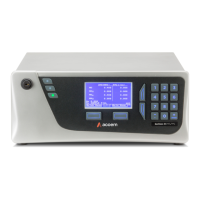Serinus 44 User Manual 3.0
Description of the NH
3
converter efficiency checks procedure.
The Serinus 44 analyser is a precision measuring device which must be calibrated against a known
source of NO & NH
3
(e.g. a certified gas cylinder).
There are several different types of checks/calibrations performed:
Level 1 Calibration – A simplified two-point instrument calibration used when instrument
linearity does not need to be checked or verified. This check is typically performed on a monthly
basis. Adjustments to the instrument response can only be made when performing level 1
calibration.
Level 2 Calibration – A simple check of the instrument’s response. Level 2 checks may be
performed using non-certified reference sources and are most often used as a performance
monitoring tool. Commonly referred to as a precision check, the instrument must not be
adjusted.
Multipoint Precision Check – A series of points (typically covering zero and 5 up-scale span
points) are supplied to the instrument. They should cover the instruments intended full scale
measurement range. These precision checks are used to determine the linearity of the
instrument response across its operating range.
Converter Efficiency Check – A measure of the efficiency of the system to convert the target gas
for subsequent measurement. A converter efficiency check is performed on a regular basis to
determine the converter performance and adjust the instruments response accordingly.
In general terms, the calibration process includes the following steps:
1. Establish a reliable and stable calibration source.
2. Perform a zero precision check or calibration – zero adjustments apply to the NO, NO
2
and
NH
3
channels.
3. Calibrate the instrument against the NO reference – this will adjust the instrument response
for the NO
X
and N
X
channels.
4. Perform a multipoint precision check using the NO reference. This determines the linear
response of the instrument across the operating range.
5. Establish a reliable and stable calibration source (reference) for NH
3.
6. Check and adjust the NH
3
converter efficiency using the ammonia reference source.
Zero and span calibrations are frequently used to provide a two-point calibration or an indication of
instrument stability and function.
A multipoint precision check is used to establish the relationship between instrument response and
gas concentration over the instrument's full scale range.
Note: Zero calibrations are not recommended by Ecotech, but maybe be performed when specifically
required by a user. Calibrating the zero tends to mask issues that should be addressed during
maintenance/service.

